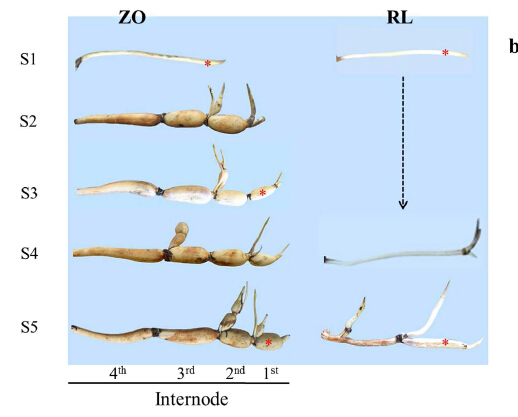Name:YANG Pingfang
Tell:
Email:yangpf@wbgcas.cn
Organization:Wuhan Botanical Garden
Transcriptomic Analysis Reveals Rhizome Regulation Mechanisms in Temperate and Tropical Lotus (Nelumbo nucifera)
2015-09-15
Rhizome, the storage organ of lotus, is a popular edible vegetable in China because of its richness in nutrients. The development of rhizome internodes can be classified into four stages: stolon stage, initial swelling, middle swelling and later swelling stage. Rhizome formation is a complex developmental process affected by many environment factors (mainly photoperiod or temperature) through triggering signal molecules or gene regulation. However, the mechanisms that control rhizome development are poorly understood.
Temperate lotus and tropical lotus, the two ecotypes of N. nucifera, differ in rhizome formation. The former has an annual growth cycle, which goes through the longitudinal growth of an underground stolon and induces swelling to enlarge girth. While, the latter has no clear girth enlargement in the entire growth period, thus can’t survive in the cold winter in the south-central regions of China, such as Wuhan. The difference between the two ecotypes provides an opportunity to study the molecular mechanisms that control rhizome girth enlargement in lotus.
YANG Mei, supervised by Prof. YANG Pingfang from Wuhan Botanical Garden, identified the differentially expressed genes involved in rhizome formation during three stages of rhizome development-stolon (T1), middle swelling (T2) and late swelling(T3) - between ‘ZO’(Z, temperate lotus) and ‘RL’(R, tropical lotus) using RNA-seq, transcriptomic analyses.
Using Illumina HiSeq sequencing, 348 million high-quality reads were obtained, and an average of 88.5% of the data was mapped to the reference genome. 26783 genes, including 2714 novel genes were assembled.
In total, 10299 differentially expressed genes (DEGs) were identified for ‘RL’ and ‘ZO’ at three stages. Hierarchical clustering plotted these DEGs into eight clusters with expression patterns, which were significantly enriched in carbohydrate metabolism and glucan metabolic process through functional analysis. Based on the analysis of the genes whose expression was highly correlated with rhizome enlargement index, 22 candidate genes for rhizome girth enlargement were identified. These results screened several DEGs and potential candidate genes involved in rhizome girth enlargement, which laid a solid foundation for future studies on molecular mechanisms underlying rhizome formation.
Results were published in Scientific Reports online entitled “Transcriptomic Analysis of the Regulation of Rhizome Formation in Temperate and Tropical Lotus (Nelumbo nucifera)”. It was financially supported by National Natural Science Foundation of China and The Knowledge Innovation Project of Chinese Academy of Sciences.

Rhizome development of ‘ZO’ and ‘RL’ (Image by WBG)